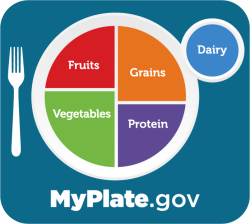Nutrition for Toddlers
It’s important to provide your toddler with foods full of nutrients, such as a variety of fruits, vegetables, grains, protein foods and dairy or fortified plant based alternatives. Avoid foods and beverages with added sugars and choose those with lower sodium.
MyPlate is a guideline to help you and your toddler eat a healthy diet. The USDA and the U.S. Department of Health and Human Services have prepared the food plate to guide parents in selecting foods for children ages 2 and older.
The MyPlate icon is divided into five food group categories, emphasizing the nutritional intake of the following:
- Grains. Foods that are made from wheat, rice, oats, and barley. Examples include whole-wheat bread, brown rice and oatmeal. Aim for mostly whole grains.
- Vegetables. Vary your vegetables. Choose a variety of colorful vegetables, including dark green, red, and orange vegetables.
- Fruits. Any fruit or 100% fruit juice counts as part of the fruit group. Fruits may be fresh, canned, frozen, or dried and may be served whole, cut up or pureed. The American Academy of Pediatrics recommends limiting juice to less than 4 ounces per day for children 1 to 3 years old.
- Dairy. Milk products and many foods made from milk are considered part of this food group. Focus on fat-free or low-fat products, as well as those that are high in calcium.
- Protein. Go lean on protein. Choose low-fat or lean meats and poultry. Vary your protein routine. Choose more fish, nuts, seeds, peas and beans.













